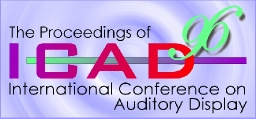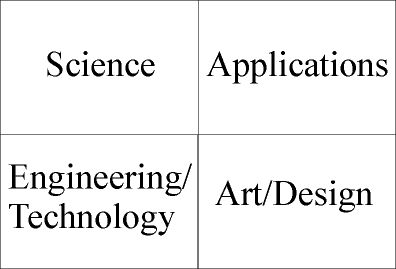

|
Introduction: Transition |

|
In a field evolving as quickly as auditory display (AD), and in a conference as young as ICAD, it should come as no surprise that every meeting is a time of transition. The first ICAD was held at the Santa Fe Institute in 1992 after nearly two years of searching for the few researchers focused on AD. ICAD '92 was then in the process of evolving from the tiny enthusiastic group that Steve Frysinger speaks of in his introduction to a small international community with renewed vigor. The progression from ICAD '92 to ICAD '94 was one of size and substance. While '92 yielded the first book in the field, enhanced visibility in the greater research community, and perhaps most importantly, had engendered a sense of momentum and possibility, ICAD '94 was three times the size and drew from a startlingly broad range of disciplines. Not only were there researchers from many disciplines for whom AD was the heart of their work (if not their financial support), but the multi-disciplinary nature of AD enticed people whose focus had been more along the lines of basic research, such as: psychoacoustics, computer science, or mathematics. while ICAD '92 had also manifested an interdisciplinary quality, the divide between the specialist and the generalist had become more prominent, and the new challenge at ICAD '94 was to integrate the research of people who were new to AD with those whose work had begun to soak into the focal core of this community. Now we find ourselves at ICAD '96. While the size of this conference might be about the same as the '94 event, the papers being presented show us that the core AD research reflects something of a maturation. We are seeing more references to earlier auditory display research, researchers following up on their earlier work or that of their colleagues, slightly more consistent vocabulary, and recurring questions in areas of psychology, design, and technology. The identity of ICAD as a forum for presenting new research has moved away from traditional single discipline work with relevence to Auditory Display, such as psychometric and computer science research (which might be just as at home at the Acoustical Society or supercomputing conferences), and toward the techniques, applications, and theories that constitute a definable field of research. In this way ICAD is a factor in focusing the exploration as to how non-speech audio can be used to convey information. We can understand the research components that are important to the ICAD community as science, technology, applications, and design. We might visualize these functions as falling within the organizing metaphor I brought up at the conference, that of quadrants. This scheme labels ICAD's component disciplines as Science, Engineering/Technology, Art/Design, and Applications.

Using these four overlapping areas of inquiry as a means of understanding ICAD's role in the development of auditory displays, we see that the papers in this proceedings all touch on more than one quadrant. In fact it is a hallmark of this conference, indeed of all ICAD's activities, that these areas overlap so completely. Engineering supports applications, science supports engineering, design supports applications which further support science, and so on. Regarding the question of predominance between research and applications, thus far, I'd say we've seen more research than applications, predictable in a field so new. If ICAD '92 and '94 saw more science-oriented efforts and theory building, ICAD '96 provided us with an extension of this and a stronger showing on the design front. The sheer love of sound, as a colleague said to me, can be a guiding force in our efforts. This love, combined with curiosity, rigor and risk seem to be the hallmarks of the International Conference on Auditory Display. One of ICAD's main functions is as a meeting place for people from many disciplines with the common interest in presenting information via non-speech audio. Increasingly, however, individual researchers are extending their expertise to include, say, sound synthesis as well as perceptual testing, or human factors as well as computer architectures. No individual, however, can hope to master all of the disciplines necessary for thorough AD research and integrated research teams will be essential to many projects. This conference provides an opportunity for these investigators to communicate with each other and with the broader research and development communities. There is a more pragmatic transition taking place at ICAD '96. At its inception ICAD was formed with the invaluable support of the Santa Fe Institute. SFI's mandate, while focused on the "Sciences of Complexity", was broad enough to encompass auditory display because it was, at least in the work of some researchers, a field which might lead to further understanding of complex systems. It has always been SFI's style to support young workshops and then, if and when, those bodies develop to fill a niche outside of their core complexity research, they are released to be independent or to affiliate elsewhere. This is where ICAD now finds itself. After six years of sponsorship by SFI, new underpinnings are in the works. A new organization has been formed to carry forward the conferences and other projects of our auditory display community. The organization is called the International Community for Auditory Display. ICAD is a not-for-profit corporation created to support research, education and community formation within the emerging field of auditory display. The primary projects of ICAD are the conferences, the listserve (icad-request@santafe.edu) and the ICAD Web site . Since auditory display researchers come from a wide variety of geographical, professional, and disciplinary backgrounds, ICAD will seek, above all, to facilitate communication across boundaries. A membership organization, the new ICAD was founded in 1996 and enthusiastically supported by the attendees of ICAD '96. People volunteered to participate in ICAD's various programs, such as the website and the conferences. ICAD continues to welcome ongoing participation from anyone who cares about the future of this research. There was broad support at the conference for annual (rather than the current bi-annual) conferences. With this in mind, ICAD '97 was slated for Xerox PARC under the Chairpersonship of Elizabeth Mynatt while ICAD '98 has been slated for a European locale. The vision of a research community continues to grow as new investigators in related fields become familiar with ICAD's research concerns and activities. None of our conferences could have occurred without financial support. In earlier years SFI not only hosted ICAD, but sustained the workshop by connecting organizers with government funding resources; ICAD also received limited private support. ICAD '94 enjoyed significantly expanded government support, primarily via NASA, and support from some private companies. The Office for Naval Research provided funding for post-ICAD activities, and out of this grew the Web page and a solid base for ICAD '96. This year, Xerox PARC has joined the Santa Fe Institute by providing personnel, AV equipment, and space for the conference. Aureal and Microsoft have generously provided funding—a sign, perhaps, that some in industry believe that the scientific and design research at ICAD points towards viable commercial applications. We hope and expect that government and industry will see the value of ICAD and continue to provide funding for the conference and related activities. A personal note: The growth of ICAD from the workshop-like event that I inaugurated in 1992 to its current state has been both hard-won and satisfying. I have long hoped for and now welcome the shift from ICAD as a project of the Santa Fe Institute and under my direction (in collaboration with the members of the various ICAD Steering Committees) to that of a project of an independent organization directed by a larger body of committed members of the research community. While I remain in a leadership role in ICAD the organization, the ICAD projects—the conferences and the Web site—are under the stewardship of leaders and committees committed to fulfilling and extending the ICAD vision. It has been a privilege to work with many fine people and high quality organizations over the past six years. It is now a pleasure to take this large step in the transition process towards ICAD's integration into the greater research arena.
Greg Kramer |
